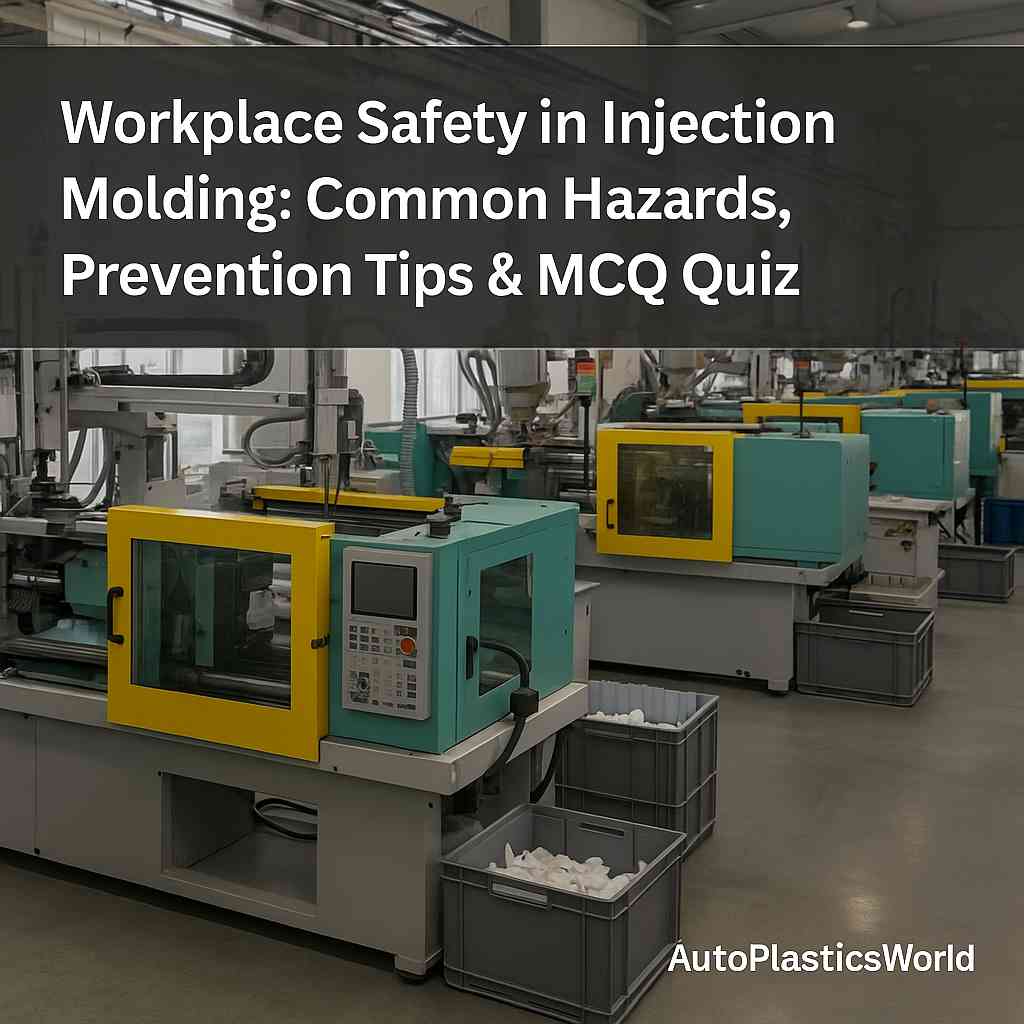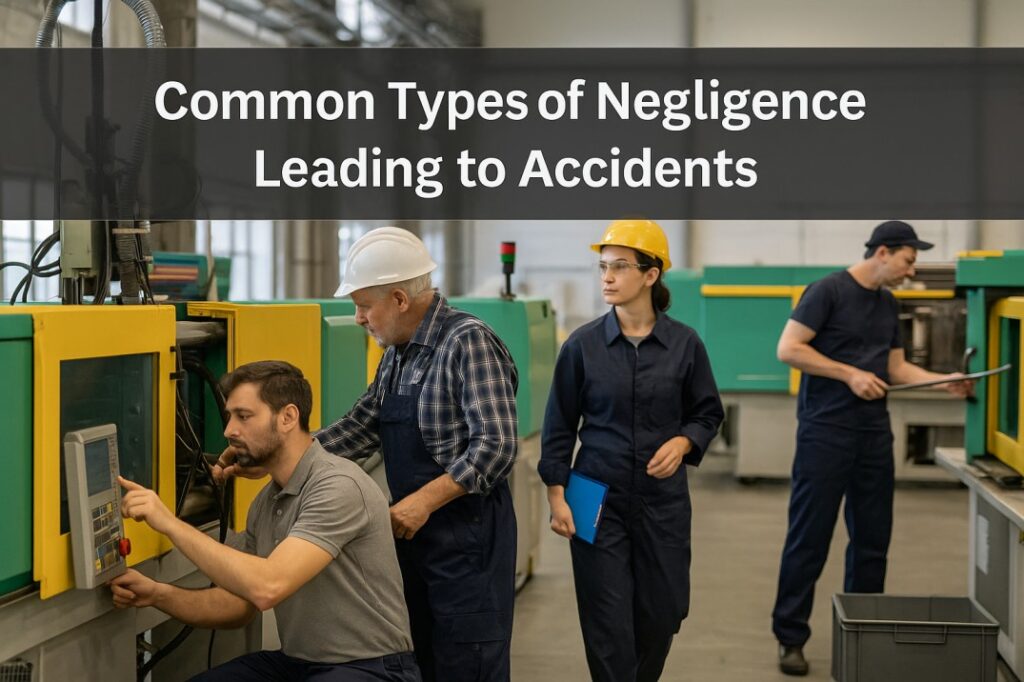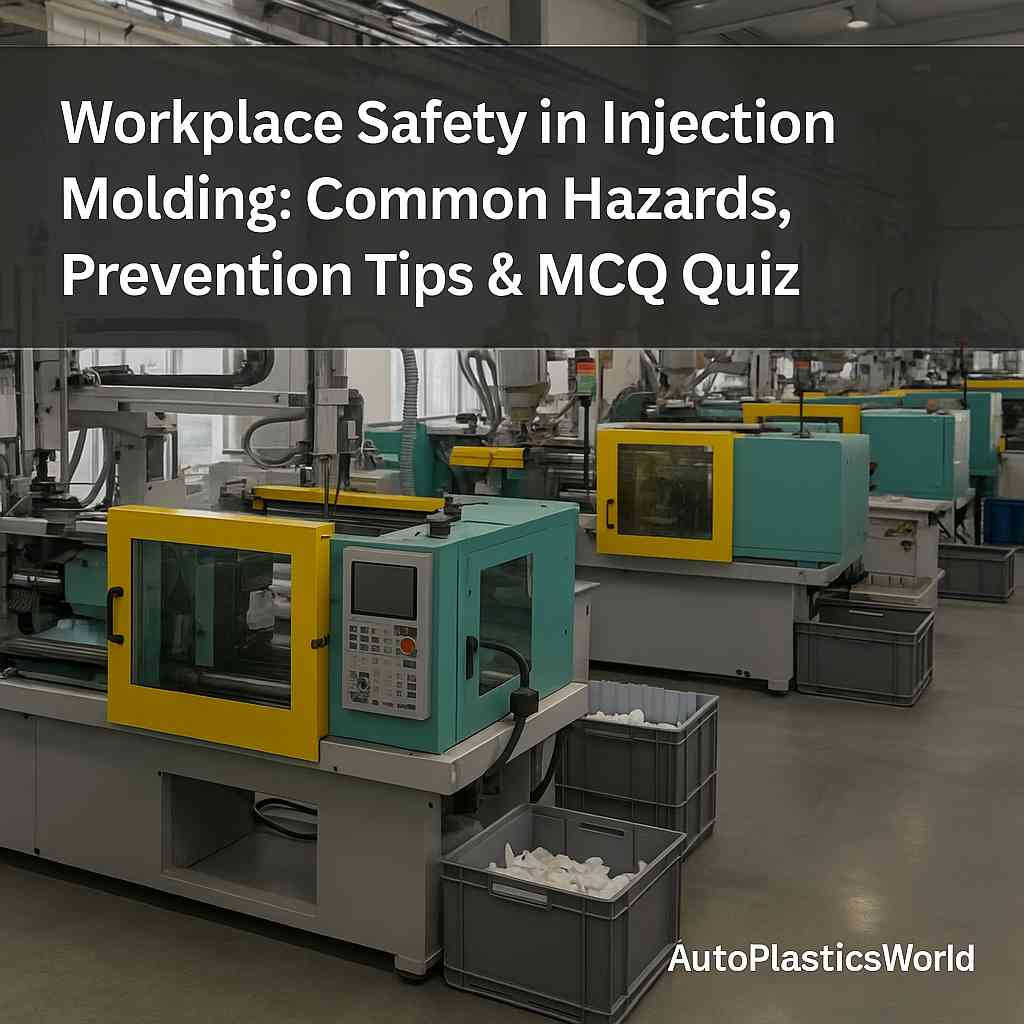Introduction
Workplace Safety in the injection molding industry is crucial to protect human life, maintain equipment integrity, and ensure efficient production. The injection molding shopfloor involves heavy machinery, high temperature, pressure systems, and hazardous materials. Even minor negligence can lead to severe accidents affecting both personnel and expensive molds/machines. This article focuses on:
- Identifying common safety risks in injection molding operations
- Types of negligence and their consequences
- Preventive measures for a safer work environment
- Best practices to maintain worker, mold, and machine safety
- A comprehensive MCQ quiz to assess training effectiveness

Shopfloor Hazards in Injection Molding Environment
- Thermal Hazards:
Molten plastic at 200–400°C
Hot runner systems and nozzle tips
Heated platens and mold surfaces - Mechanical Hazards:
Moving platens
Ejector pins
Robotic arms and conveyor systems
Clamping units (can exert tons of force) - Electrical Hazards:
High-voltage heater bands
Servo motors and control panels - Chemical Hazards:
Fumes from melted polymers (PVC, ABS, Nylon)
Mold release agents and cleaning solvents - Trip/Fall Hazards:
Oil spills
Improper cable management
Random placement of tools
Common Types of Negligence Leading to Accidents

- Man-related Negligence:
- Not wearing PPE
- Reaching into the mold during auto-cycle
- Overriding safety interlocks
- Fatigue and lack of attention
- Mold-related Negligence:
- Not inspecting mold bolts, eye bolts before lifting
- Improper mold installation and clamping
- Ignoring water leakage or oil seepage
- Not following shutdown/startup procedures
- Machine-related Negligence:
- Bypassing limit switches
- Running with malfunctioning sensors
- Poor maintenance schedule
- Overloading tonnage capacity
- Material Handling Negligence:
- Incorrect drying of hygroscopic materials
- Unlabeled/expired material use
- Manual feeding in hot hopper
How to Avoid Accidents: Preventive Measures
General Shopfloor Safety Practices
- Always wear PPE: gloves, helmet, goggles, antistatic shoes
- Follow Lockout-Tagout (LOTO) procedures before maintenance
- Use shadow boards for tools to prevent loose items
- Keep pathways clear and dry
- Display emergency evacuation routes and safety signs
Machine-Specific Safety Measures
- Ensure all safety interlocks are functional
- Do not bypass doors, guards, or safety mats
- Regularly inspect hydraulic and electrical systems
- Perform preventive maintenance as per OEM guidelines
- Keep emergency stop buttons accessible and functional
Mold-Specific Safety Protocols
- Use rated eye bolts and lifting chains
- Confirm mold weight and machine capacity before mounting
- Tighten clamping bolts to recommended torque
- Check ejector alignment and mold movement clearance
- Monitor hot runner temperature to avoid thermal damage
Material Safety Guidelines
- Dry materials as per data sheet recommendations
- Store chemicals in labeled containers with MSDS
- Avoid manual contact with molten plastic
- Use vent hoods and exhausts for fume extraction
Worker Behavior and Responsibility
- Undergo mandatory safety training before operating machines
- Report any unsafe condition immediately to supervisor
- Avoid operating machines under fatigue or influence
- Adhere strictly to operation manuals
- Never work alone during mold changeovers or maintenance
Emergency Preparedness
- First-aid kit availability and trained staff
- Fire extinguishers and fire exit routes clearly marked
- Eye wash stations for chemical exposure
- Regular emergency drills for all workers
- Emergency contact list on all notice boards
Maintenance Safety
- Lockout and depressurize hydraulic/pneumatic lines
- Allow mold to cool before servicing
- Use insulated tools near live panels
- Check grounding of machines regularly
- Maintain logbook for all safety and maintenance checks
Best Practices for a World-Class Safety Culture
- 5S Implementation (Sort, Set in order, Shine, Standardize, Sustain)
- Daily safety toolbox talks
- Monthly safety audits
- Kaizen for hazard identification and removal
- Digital dashboards for real-time safety metrics
25 MCQ for Safety Awareness (Correct Answer Highlighted)
What is the first step before performing maintenance on any molding machine?
- A. Call the supervisor
- B. Clean the machine
- C. Lockout and tag the machine
- D. Turn off lights
Which of the following is NOT a PPE?
- A. Safety goggles
- B. Sandals
- C. Gloves
- D. Safety helmet
Which component is most dangerous during auto ejection?
- A. Heater band
- B. Ejector pin
- C. Hopper dryer
- D. Thermocouple
What should you do if oil is leaking near a running machine?
- A. Ignore and continue
- B. Inform maintenance and stop the machine
- C. Mop the floor and walk away
- D. Pour water on it
How often should emergency drills be conducted?
- A. Once a year
- B. Once every quarter
- C. Every month
- D. Only after incidents
Which type of plastics are most dangerous when overheated?
- A. PP and PE
- B. PS and HIPS
- C. PVC and ABS
- D. Nylon and PET
To prevent trip hazards, one should:
- A. Wear long pants
- B. Increase lighting
- C. Keep floor clean and organized
- D. Use loud alarms
What is the best method to identify unknown material?
- A. Smell test
- B. Burn test
- C. Material datasheet and labeling
- D. Ask operator
In case of fire, what should be used first?
- A. Water
- B. Plastic bucket
- C. Fire extinguisher
- D. Wooden stick
Emergency stop button should be tested:
- A. Annually
- B. When machine is idle
- C. Periodically as per safety plan
- D. Only after incidents
Machine interlocks are designed to:
- A. Stop noise
- B. Save electricity
- C. Prevent access during operation
- D. Cool down mold
Why should mold bolts be checked regularly?
- A. To change size
- B. To avoid mold fall or misalignment
- C. To make operator happy
- D. To reduce cycle time
Where should chemical MSDS be stored?
- A. In HR office
- B. Near chemical storage area
- C. In locker room
- D. With operator
The best way to lift a heavy mold is by:
- A. Asking 3-4 workers
- B. Using rated crane and lifting eye bolts
- C. Dragging slowly
- D. Using forklift from side
What is the minimum PPE while operating molding machine?
- A. Shorts and slippers
- B. Glasses and cap
- C. Helmet, gloves, shoes, goggles
- D. Lab coat
Why should materials be dried before molding?
- A. Save electricity
- B. Make it shine
- C. Remove moisture to prevent defects
- D. Increase weight
Who is responsible for reporting safety hazards?
- A. Supervisor only
- B. Every employee
- C. Security guard
- D. HR person
Best way to avoid electrical hazard:
- A. Ignore sparks
- B. Use insulated tools and check grounding
- C. Pour water
- D. Tighten screws with hands
Mold cooling system leak can cause:
- A. No effect
- B. Short circuit and corrosion
- C. Better molding
- D. Lower temperature only
Incorrect mold alignment may cause:
- A. Noise only
- B. Mold damage and part defects
- C. Good bonding
- D. Heat saving
What is the risk if ejector pin is not aligned?
- A. Better ejection
- B. Mold damage and part sticking
- C. Lower pressure
- D. No risk
Conclusion
Injection molding safety is not an optional discipline but an essential culture that must be embraced by everyone on the shopfloor. Awareness, training, discipline, and preventive measures are the pillars of a zero-accident work environment. Following these guidelines ensures the safety of operators, extends the life of machines and molds, and improves productivity.
To connect with the admin of this site :


I went over this website and I think you have a lot of excellent information, bookmarked (:.
I was examining some of your blog posts on this internet site and I conceive this internet site is rattling instructive! Keep on posting.
Sure, just stay connected with us
I do believe all of the ideas you have introduced for your post. They are very convincing and will definitely work. Still, the posts are too brief for novices. May you please prolong them a bit from subsequent time? Thank you for the post.